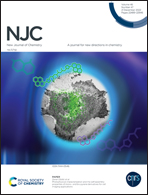Nanohybrids as a tool to control the dispersion of organic emitters in solution-processed electroluminescent layers†
Abstract
Fluorescent organic–inorganic nanohybrids based on π-extended hydroxyoxophosphole emitters grafted onto ZnO nanocrystals, have been introduced as an efficient way to control the spatial arrangement of the organic emitters within a host material. The homogeneous dispersion of the emissive nanohybrids within a host matrix is achieved via co-grafting of an additional surfactant, leading to very smooth films with low roughness. Interestingly, the co-grafting of this surfactant not only improves the thin film morphology but also enhances its photoluminescence quantum yield and allows for the easy solution-processing of this material as an emissive layer in a simplified OLED structure. These devices display strongly improved performances, by more than one order of magnitude, compared to OLEDs using pure nanohybrids. These promising results prove the potential of this technique to graft any type of luminophore in efficient solution-processed light-emitting devices.



 Please wait while we load your content...
Please wait while we load your content...